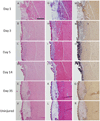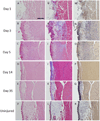Classification for animal vocal fold surgery: resection margins impact histological outcomes of vocal fold injury
- PMID: 24965969
- PMCID: PMC4213306
- DOI: 10.1002/lary.24799
Classification for animal vocal fold surgery: resection margins impact histological outcomes of vocal fold injury
Abstract
Objectives/hypothesis: Extent of vocal fold injury impacts the nature and timing of wound healing and voice outcomes. However, depth and extent of the lesion created to study wound healing in animal models vary across studies, likely contributing to different outcomes. Our goal was to create a surgery classification system to enable comparison of postoperative outcomes across animal vocal fold wound-healing studies.
Study design: Prospective, controlled animal study.
Methods: Rats underwent one of three types of unilateral vocal fold surgeries classified by depth and length of resection. The surgeries were: for subepithelial injury, resection of epithelium and superficial layer of the lamina propria at the midmembranous portion of the vocal fold; for transmucosal injury, resection of epithelium and lamina propria; and for transmuscular injury, resection of epithelium, lamina propria, and superficial portion of the vocalis muscle. Wound healing was evaluated histologically at various time points up to 35 days postinjury.
Results: Complete healing occurred by 14 days postsurgery for subepithelial injury, and by day 35 for transmucosal injury. Injury remained present at day 35 for transmuscular injury.
Conclusions: Timing and completeness of healing varied by extent and depth of resection. Scarless healing occurred rapidly following subepithelial injury, whereas scarring was observed at 5 weeks after transmuscular injury. The proposed classification system may facilitate comparison of surgical outcomes across vocal fold wound-healing studies.
Levels of evidence: N/A.
Keywords: Surgical classification; animal model; vocal fold injury; wound healing.
© 2014 The American Laryngological, Rhinological and Otological Society, Inc.
Conflict of interest statement
No author declares a conflict of interest.
Figures




References
-
- Tateya T, Tateya I, Sohn JH, Bless DM. Histologic characterization of rat vocal fold scarring. Ann Otol Rhinol Laryngol. 2005;114:183–191. - PubMed
-
- Rousseau B, Hirano S, Chan RW, Welham N, Thibeault S, Ford C, Bless D. Characterization of chronic vocal fold scarring in a rabbit model. J Voice. 2004;18:116–124. - PubMed
-
- Cho SH, Kim HT, Lee IJ, Kim MS, Park HJ. Influence of phonation on basement membrane zone recovery after phonomicrosurgery: a canine model. Ann Otol Rhinol Laryngol. 2000;109:658–666. - PubMed
Publication types
MeSH terms
Grants and funding
LinkOut - more resources
Full Text Sources
Other Literature Sources
Medical
Research Materials

